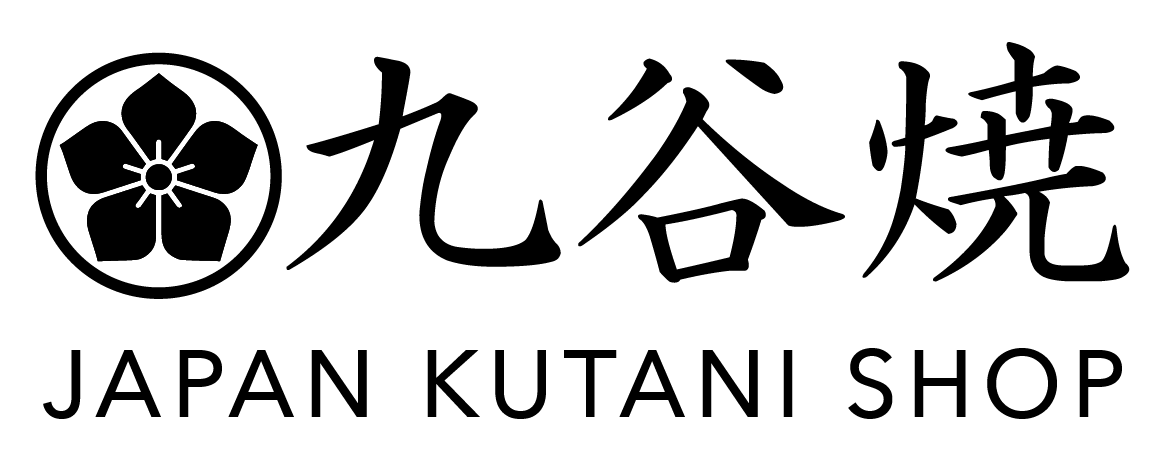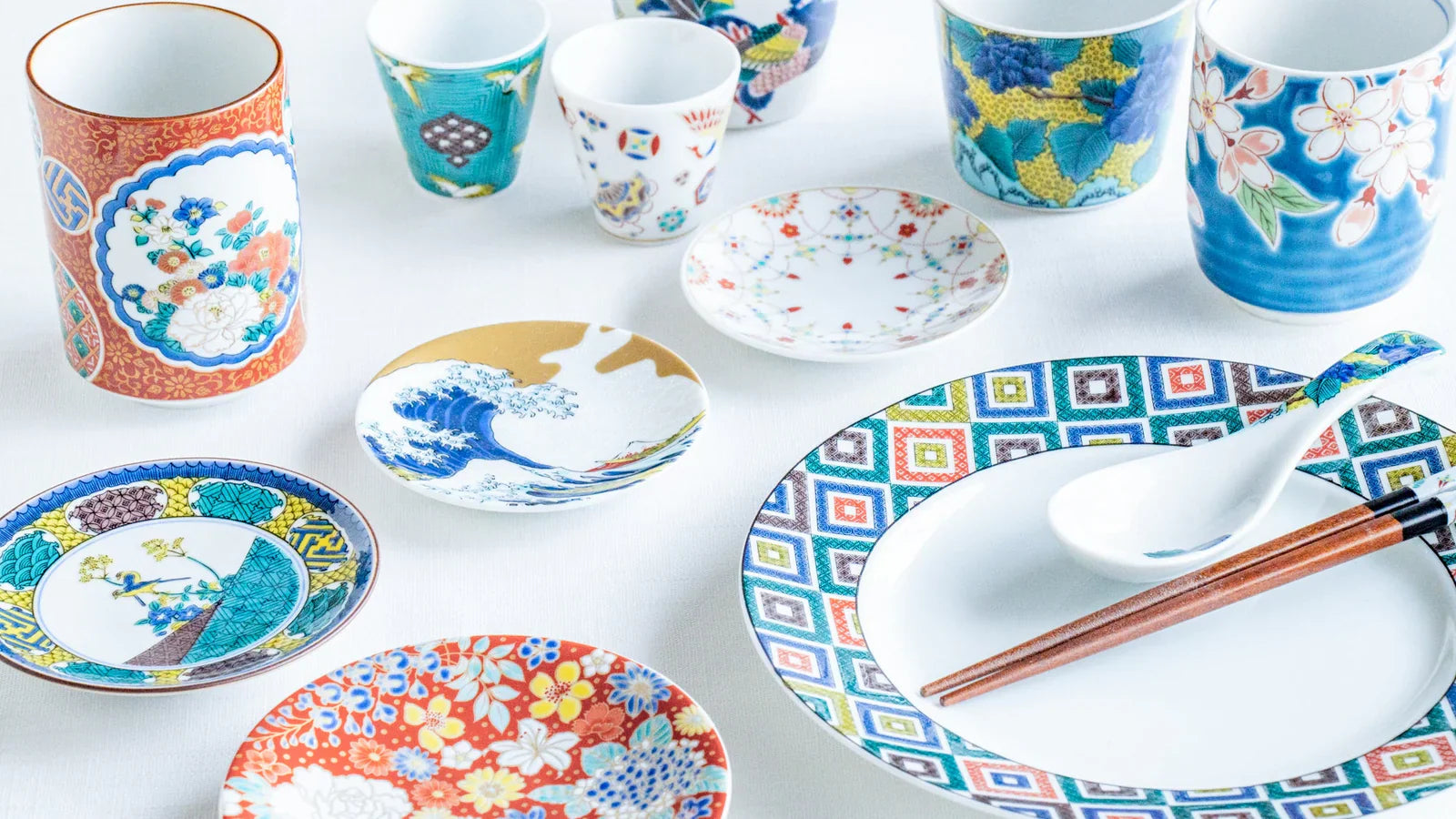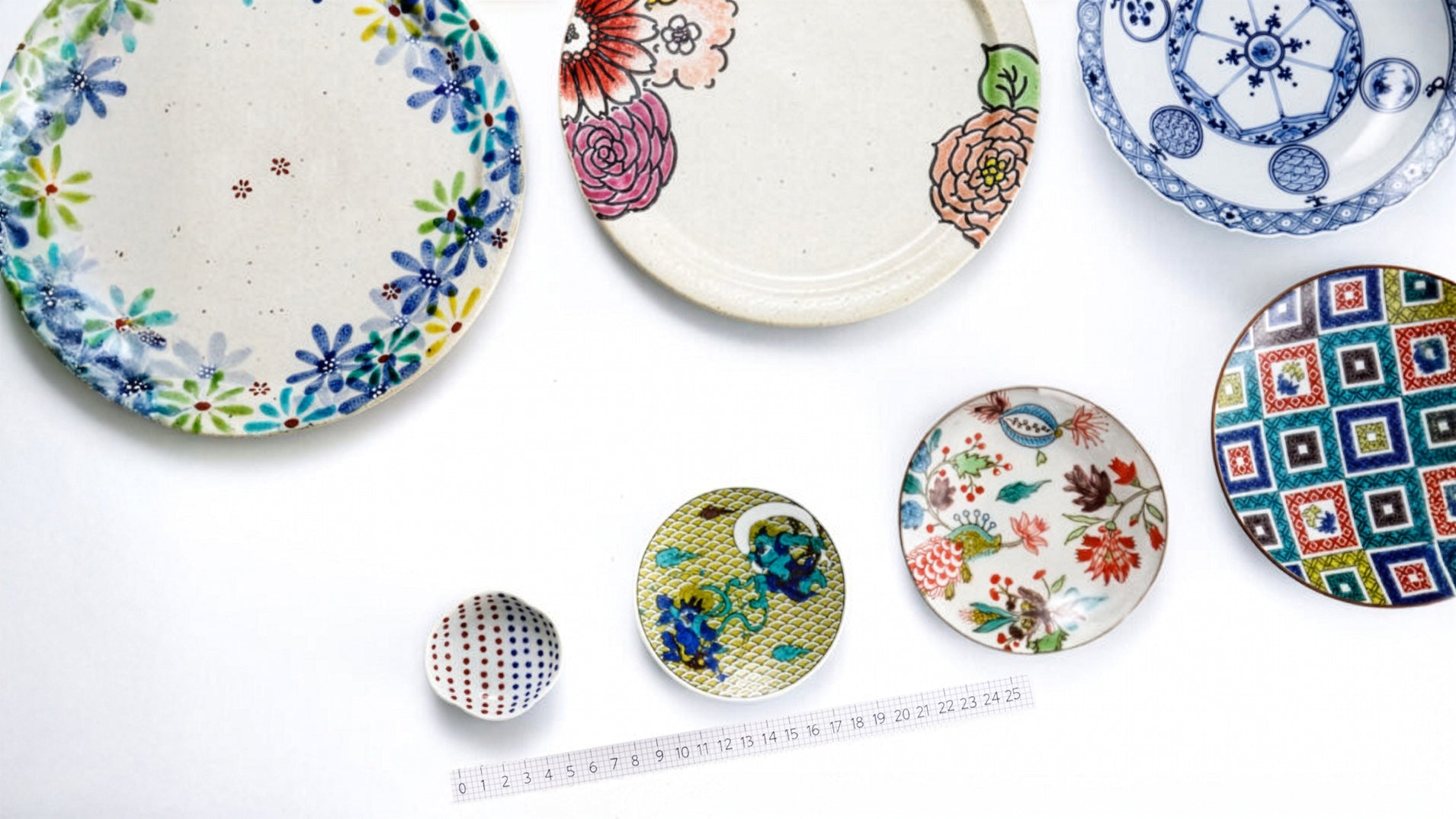
What Is Kutani Ware?
Written by Team Japan Kutani
Kutani ware is a type of ceramic from the southern cities of Ishikawa Prefecture, such as Kaga, Komatsu, Nomi, and Kanazawa. It originated approximately 370 years ago during the early Edo period (1603–1868 CE), when overglaze porcelain was fired in a kiln deep in the mountains of Kutani Village (now part of Yamanaka Onsen, Kaga City). As the kiln was established in Kutani Village, the pieces became known as Kutani-yaki, or Kutani ware in English. Today, Kutani ware is recognized as one of the most esteemed traditional crafts both in and outside of Japan.

TABLE OF CONTENTS
The Characteristics of Kutani Ware
One of the defining features of Kutani ware is its overglaze decoration—the painted designs and embellishments applied to the surface of the vessel. Many of these decorations use traditional Japanese pigments, known as wa-enogu. Designs painted with wa-enogu are admired for their elegant appearance and rich, vibrant colors.

The methods of overglaze decoration in Kutani ware are incredibly diverse—so much so that it's often said there are as many styles as there are kilns. This strong dedication to overglaze techniques by each artisan or kiln, along with the wide variety of expressive styles, is one of the most distinctive and fascinating aspects of Kutani ware. This range in artistic expression isn’t a recent development. Throughout its 370-year history, Kutani ware has continued to evolve, with each era producing new painting styles and techniques.
Japanese Pigments Used in Kutani Ware
Wa-enogu, or Japanese pigments used in Kutani ware, form a traditional palette known as Kutani gosai, the traditional five colors of Kutani ware. These five core hues are green, yellow, purple, navy blue, and red.

When fired, the green, yellow, purple, and navy blue wa-enogu transform into a glass-like glaze, giving Kutani ware its distinctive depth and glossy finish. In contrast, red behaves differently—it doesn’t form a thick glaze, but excels at producing fine, delicate lines.
The outlines of Kutani ware designs are typically drawn with a pigment called gosu. This outlining technique is known as honegaki, which forms the structural framework of the artwork.
Plate outlined in red and gosu (honegaki stage)

Next, the green, yellow, purple, and navy blue pigments are layered over the gosu outlines.
Plate layered with wa-enogu (Japanese paint)

Green, yellow, purple, and navy blue—only develop their true colors after firing, so before firing, they appear completely different in color and lack glossiness.
Plate after firing

When fired, these four colors take on a glass-like appearance, allowing the gosu outlines beneath to show through and complete the design. The glossy finish, unique to this vitrified surface, is also beautifully striking.
Is Kutani Ware Porcelain or Stoneware?
Kutani ware is classified as overglaze ceramics. In other words, some Kutani pieces are porcelain with overglaze decoration, while others are stoneware. The difference between porcelain and stoneware lies in the raw materials. Even within Kutani ware, porcelain and stoneware have significantly different finishes, including differences in texture and in the character of the overglaze.
Porcelain
The main raw material for porcelain is stone, such as pottery stone. Porcelain has a smooth, glass-like surface and is white. This white base allows painted designs and gold decoration to stand out with clarity and brilliance. When tapped lightly, it produces a high-pitched, metallic sound.

Stoneware
The main raw material for stoneware is clay, which is known for its earthy character and warmth. The type of glaze applied can give the surface a unique texture and expression. When lightly tapped, it produces a low, dull sound.

Styles and Techniques of Kutani Ware
Kutani ware encompasses a wide variety of expressive methods. Below are popular styles (designs and painting styles) and key techniques often associated with Kutani ware.
Ko-Kutani

Ko-Kutani refers to the early period of Kutani ware. The ko-Kutani style refers to pieces that recreate the decorative techniques of early Kutani ware, often applying designs from large plates onto smaller items like sauce dishes. These pieces feature traditional motifs such as flowers, birds, and seasonal scenes, painted using the Kutani gosai—green, yellow, purple, navy blue, and red—and sometimes reflect the aote (blue-green) style as well. Ko-Kutani-style tableware remains popular today as it offers the charm of this early style into everyday modern life.
Mokubei

The Mokubei style is inspired by the paintings of Aoki Mokubei, a master craftsman of the Edo period. It is characterized by red backgrounds featuring karako, children in Chinese-style hairstyles and clothing, often depicted with expressive faces and gestures that add a unique charm. Mokubei motifs remain popular today and are still seen in contemporary Kutani ware.
Yoshidaya

This style draws on the painting tradition that inherits the aote of ko-Kutani. Aote refers to a technique that uses the four colors of green, yellow, purple, and navy blue. The colors are applied in an almost oil painting-like manner, covering the entire surface. While ko-Kutani’s aote is known for its boldness, Yoshidaya’s aote is said to have a more refined and elegant feel. Designs in the Yoshidaya style are vivid yet composed, bringing a graceful vibrancy to the modern dining table.
Iidaya Style, Hachirode, and Akae Saibyo

Iidaya and Hachirode both refer to what is now known as akae saibyo. Akae saibyo is a style in which red fine lines are painted using an extremely thin brush. The intricate patterns and images formed by these delicate lines are exceptional showcases of craftsmanship and technique. Some pieces feature gold detailing over the red painting, creating a rich and festive finish.
Eiraku, Kinrande

Kinrande is a decorative technique in which a red background is fully painted in, and patterns are rendered using only kinsai (overglaze gold). During the late Edo period, Eiraku Wazen introduced and established this technique. As a result, the kinrande style is often referred to as the Eiraku style.
With gold patterns standing out against a deep red ground, kinrande has a lavish and noble character. Some pieces showcase kinrande selectively—on the rim or handle—adding a touch of richness to the form.
Shoza

The Shoza style is based on the painting style of Kutani Shoza, a potter who was active during the Meiji era (1868–1912 CE). The Shoza-style overglaze skillfully incorporates a wide range of techniques found in Kutani ware—including ko-Kutani, akae saibyo, kinrande, and kinsai—resulting in pieces that are richly ornate and visually striking. These works bring brightness to the dining table and are well-suited for festive or special occasions.
Sometsuke

Sometsuke refers to pieces decorated only with blue on white porcelain. Unlike the vividly colored overglaze styles that use the five colors of Kutani ware, sometsuke has a more subdued beauty and quiet charm. The designs are painted with a pigment called gosu on the bisque-fired base, and when fired, the gosu transforms into a beautiful indigo blue. Sometsuke ware also enhances the presentation of food, adding a touch of brightness to the dish when plated.
Saiyu

Saiyu is a style that captivates not through painted designs, but through the transparency and depth of glaze. When the entire surface is coated with glaze and fired, it transforms into a glassy layer that gives the piece a beautiful sheen. By layering glazes of varying depth in hue, artists can achieve rich color gradations. Third generation Tokuda Yasokichi, who pursued and perfected this technique, was designated a Living National Treasure for his work in saiyu porcelain.
Aochibu

Aochibu is a decorative technique in which small raised dots are painted using green wa-enogu—though traditionally, this color was referred to as “ao,” or blue. Rather than filling or outlining, this method creates a pattern entirely through clusters of dots, producing a unique and intricate visual world. Achieving dots of uniform size while maintaining overall harmony requires a high level of skill. The smaller the dots, the greater the mastery. In addition to aochibu, there are also white-dot and gold-dot variations known as shirochibu and kinchibu.
Yuri Kinsai

Yuri kinsai is a decorative technique in which gold leaf, often cut into intricate shapes of flowers or leaves, is carefully applied to a porcelain surface, then covered with a transparent glaze and fired. The interplay between the glaze’s clarity and the shimmer of gold leaf creates a luminous, captivating finish.
This technique was originally conceived by Takenaka Ariatsu of Kanazawa. It was further studied and refined by Yoshita Minori, who was later designated a Living National Treasure for his mastery of this craft.
Yuri Ginsai

This technique involves applying silver leaf cut into decorative shapes onto the surface, then coating with glaze before firing. Normally, silver oxidizes and darkens when exposed to air, but sealing it beneath the glaze prevents this, preserving its clarity.
The result is a soft shimmer that captivates with quiet beauty.
Hanazume

The hanazume technique involves painting the surface of a piece with densely arranged floral motifs. It is believed to have been introduced to Kutani ware during the Taisho period (1912–1926 CE). Unlike most Kutani ware, which uses traditional wa-enogu, hanazume is painted with Western pigments.
Flowers are painted to fill the surface, then fired. Each flower is then outlined with kinsai and fired again to complete the piece. The result is a rich interplay between the vibrant colors of the blossoms and the luster of gold.
In contrast to the thickly applied wa-enogu, Western pigments create a lighter effect known in Kutani ware as usue or light painting, which is recognized as one of its distinct styles and techniques.
Mohitsu Saiji

This technique involves writing flowing passages of classical Japanese literature, such as poems from the Kokin Wakashu, using an ultra-fine brush. It was established in the late Meiji era by Oda Seizan, and is known as a closely guarded, hereditary technique. Today, works by the fourth generation successor, Tamura Seito, remain consistently popular. Even when magnified, the meticulously aligned characters retain the beauty and grace of traditional brush calligraphy.
Kutani ware continues to delight collectors and enthusiasts through its diverse styles and techniques used by different artists and kilns. Exploring the unique creators behind these works can be a rewarding experience.





Leave a comment
This site is protected by hCaptcha and the hCaptcha Privacy Policy and Terms of Service apply.